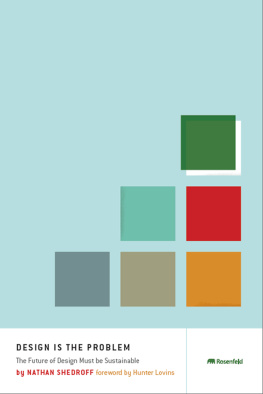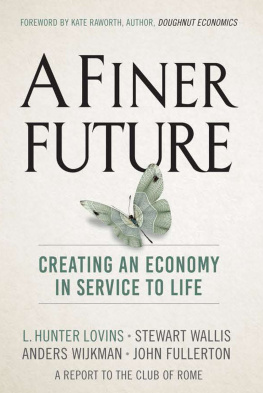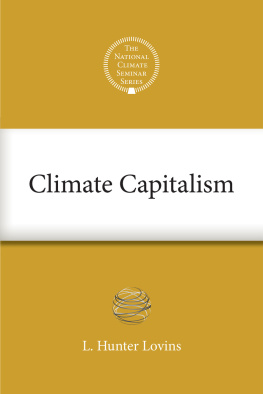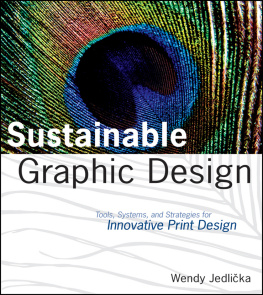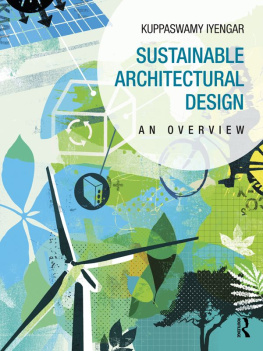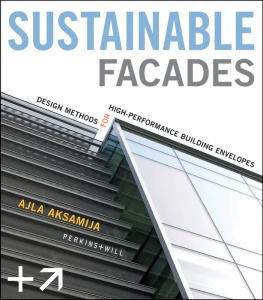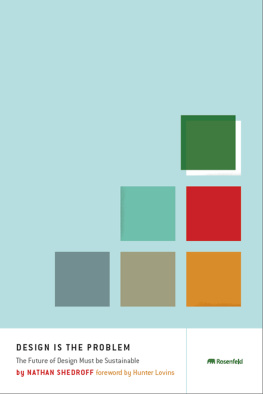Lovins L. Hunter - Design is the Problem: The Future of Design Must Be Sustainable
Here you can read online Lovins L. Hunter - Design is the Problem: The Future of Design Must Be Sustainable full text of the book (entire story) in english for free. Download pdf and epub, get meaning, cover and reviews about this ebook. City: Brooklyn;N.Y, year: 2009, publisher: Rosenfeld Media, genre: Romance novel. Description of the work, (preface) as well as reviews are available. Best literature library LitArk.com created for fans of good reading and offers a wide selection of genres:
Romance novel
Science fiction
Adventure
Detective
Science
History
Home and family
Prose
Art
Politics
Computer
Non-fiction
Religion
Business
Children
Humor
Choose a favorite category and find really read worthwhile books. Enjoy immersion in the world of imagination, feel the emotions of the characters or learn something new for yourself, make an fascinating discovery.
- Book:Design is the Problem: The Future of Design Must Be Sustainable
- Author:
- Publisher:Rosenfeld Media
- Genre:
- Year:2009
- City:Brooklyn;N.Y
- Rating:3 / 5
- Favourites:Add to favourites
- Your mark:
- 60
- 1
- 2
- 3
- 4
- 5
Design is the Problem: The Future of Design Must Be Sustainable: summary, description and annotation
We offer to read an annotation, description, summary or preface (depends on what the author of the book "Design is the Problem: The Future of Design Must Be Sustainable" wrote himself). If you haven't found the necessary information about the book — write in the comments, we will try to find it.
Design is the Problem: The Future of Design Must Be Sustainable — read online for free the complete book (whole text) full work
Below is the text of the book, divided by pages. System saving the place of the last page read, allows you to conveniently read the book "Design is the Problem: The Future of Design Must Be Sustainable" online for free, without having to search again every time where you left off. Put a bookmark, and you can go to the page where you finished reading at any time.
Font size:
Interval:
Bookmark:
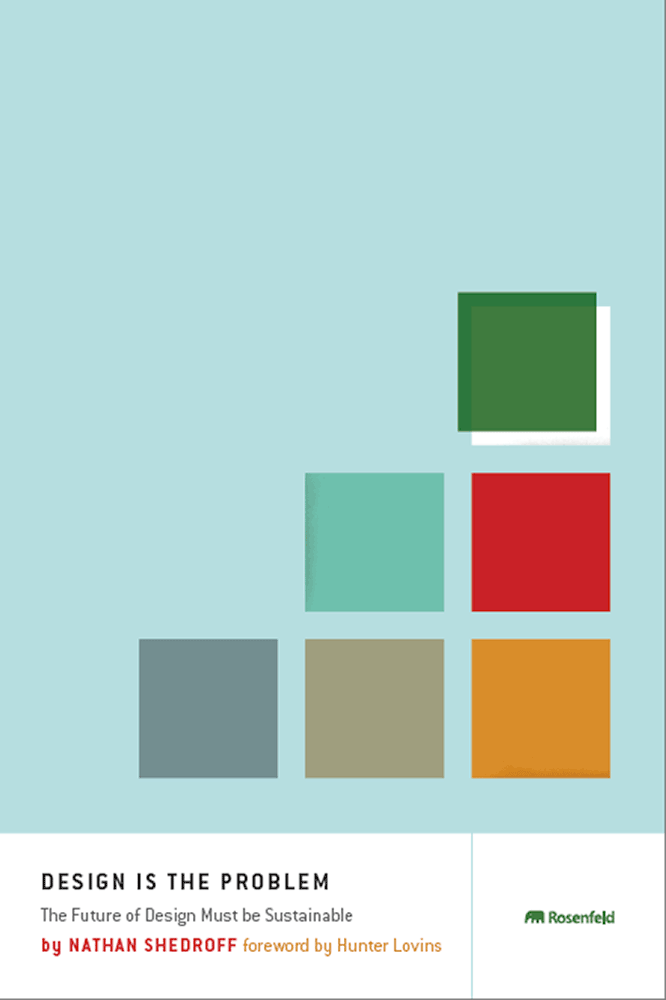
Design Is the Problem:
The Future of Design Must Be Sustainable
By Nathan Shedroff
Rosenfeld Media, LLC
705 Carroll Street, #2L
Brooklyn, New York
11215 USA
On the Web: www.rosenfeldmedia.com
Please send errors to:
Publisher: Louis Rosenfeld
Editor/Production Editor: Marta Justak
Interior Layout: Susan Honeywell
Cover Design: The Heads of State
Indexer: Nancy Guenther
Proofreader: Kezia Endsley
2009 Rosenfeld Media, LLC
All Rights Reserved
ISBN: 1-933820-01-2
ISBN-13: 978-1-933820-01-9
Library of Congress Control Number: 2008943283
Printed and bound in the United States of America
I believe that design is how we change the world. Designers are incredibly optimistic peoplebelieving that they can, absolutely, change the world for the better. However, even without a design background or education, it doesnt mean you dont or cant make change in the worldand change for the better.
This book was written for the designer in all of us. While it is primarily targeted at those who call themselves designers, it doesnt use any design jargon and is just as helpful to engineers, managers, students, and anyone who wants to build a better, more sustainable world. Whether you are involved with the creation of products, services, online experiences, events, environments, or mechanisms that drive systems (like the economy), understanding sustainability issues, frameworks, and strategies can help you create better solutions.
This book wont make you an expertonly experience and time can do that. However, its designed to help you get acquainted quickly with state-of-the-art methods in the sustainability domains and to put you far out in front of most of your peers.
This book is a summary of what I feel are the most important approaches and aspects of sustainable design. It doesnt cover everything and it only goes into so much depth. However, it should serve not only as a good introduction, but also help people put sustainable design practices into their work, no matter what they do. It is also filled with a number of references and resources that will serve as great next steps as readers decide to explore more.
This book is organized into five main sections: Reduce, Reuse, Recycle, Restore, and Process.
These sections contain 15 chapters filled with advice and examples for making better strategies regarding sustainable solutions.
This section, Reduce, focuses on the strategies for reducing material and energy impacts. It is the first place to start in designing or redesigning anything because reducing these impacts is imperative.
The two chapters in this section focus on strategies for making solutions (products, services, environments, or mechanisms) last longer and finding other uses when finished.
Just because something is recyclable, that doesnt mean its actually recycled. There are several strategies for developing products to be more easily recycled that both reclaim as much residual value as possible and prevent virgin materials from needlessly being used.
Developing a more sustainable product or service is important, but its often not enough. Aside from reducing the impact our activities have on the future, we have a lot of work left in order to correct for the impacts weve had in the past. This section describes how we need to rethink systems in order to have positive results, rather than merely reducing our negative results.
Once we have an understanding of the strategies we can use, we need to understand how to put them into the processes we utilize every day. These three chapters describe how easily sustainability can be inserted into processes we already use, how to measure our results, and how to talk to other people about them.
This books companion Web site (  rosenfeldmedia.com/books/sustainable-design/ ) contains pointers to useful sustainable design resources that Ive found and written. It includes a calendar of my upcoming talks and a place for you to engage in discussion with others who are interested in sustainable design. We expect to post information on new sustainable design-related resources and special discounts for related applications as they become available. You can keep up with the site by subscribing to its RSS feed (
rosenfeldmedia.com/books/sustainable-design/ ) contains pointers to useful sustainable design resources that Ive found and written. It includes a calendar of my upcoming talks and a place for you to engage in discussion with others who are interested in sustainable design. We expect to post information on new sustainable design-related resources and special discounts for related applications as they become available. You can keep up with the site by subscribing to its RSS feed (  feeds.rosenfeldmedia.com/sustainable-design/ ).
feeds.rosenfeldmedia.com/sustainable-design/ ).
Weve also made the books diagrams, screenshots, and other illustrations available under a Creative Commons license for you to download and use in your own presentations. Unfortunately, these dont include certain images weve only received permission to print for copyright reasons (such as the photos of cars or other examples). Youll find the books original illustrations and diagrams in Flickr (  www.flickr.com/photos/rosenfeldmedia ).
www.flickr.com/photos/rosenfeldmedia ).
Any book about sustainability runs the risk of not practicing what it preaches. Its a fair question to ask why this information is in a book at allwhy it requires paper, printing, binding, and transporting to be effective. Why cant it be distributed and consumed electronically? The answer is that it could. In fact, it is. This book is available as a downloadable PDF file from  rosenfeldmedia.com .
rosenfeldmedia.com .
Why then a book as well? The answer is simple. In order to be effective, information must fit the needs of its audience. Paper is still so satisfying to most peopleand especially designerswho prefer to purchase and read a book. Often, its more tangible, and the material seems more real.
In addition, many readers still value physical products more than virtual ones. We still expect virtual products to be free (or mostly so) and physical products to cost something. Although the value of the information contained in both is the same, we value each medium differently in both economic and emotional terms. With the actual printed book, you can dog-ear it, write notes, and highlight passages. However, you can store the digital edition easily on your hard drive and keep it with you everywhere you go, use search and backup features, and share it (but please dont go crazy or my publisher wont ask me to write many more books). People can grab a book off a bookshelf, instead of looking for the PDF on a backup drive two years from now.
The sales of each edition will give us valuable data as to how willing people are to embrace fully-digital publishing and how viable it might be to publish without paper in the future. Perhaps our preferences will shift and books will primarily be electronic fairly soon. This would certainly improve their environmental impact.
Sustainability is an approach to design and development that focuses on environmental, social, and financial factors that are often never addressed. Sustainable solutions strive to improve the many systems that support our lives, including efficiently using capital and markets, effectively using natural resources, and reducing waste and toxins in the environment while not harming people in societies across the Earth. Sustainability focuses on efficient and effective solutions that are better for society, the environment, and companies. Sustainable organizations are often more successful when they pay attention to the details of waste and impacts, allowing them to function more cleanly, increase profit margins, and differentiate themselves from other organizations.
Font size:
Interval:
Bookmark:
Similar books «Design is the Problem: The Future of Design Must Be Sustainable»
Look at similar books to Design is the Problem: The Future of Design Must Be Sustainable. We have selected literature similar in name and meaning in the hope of providing readers with more options to find new, interesting, not yet read works.
Discussion, reviews of the book Design is the Problem: The Future of Design Must Be Sustainable and just readers' own opinions. Leave your comments, write what you think about the work, its meaning or the main characters. Specify what exactly you liked and what you didn't like, and why you think so.

